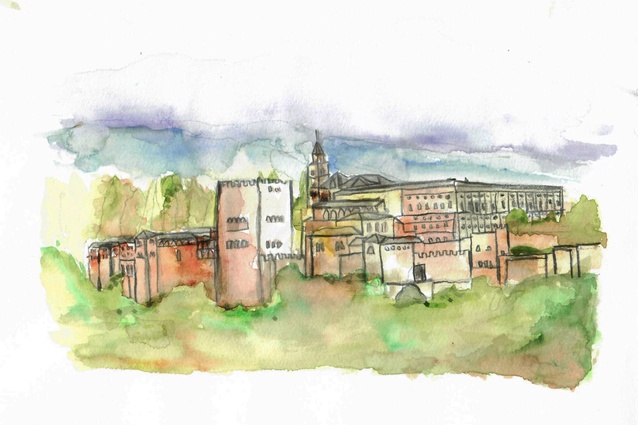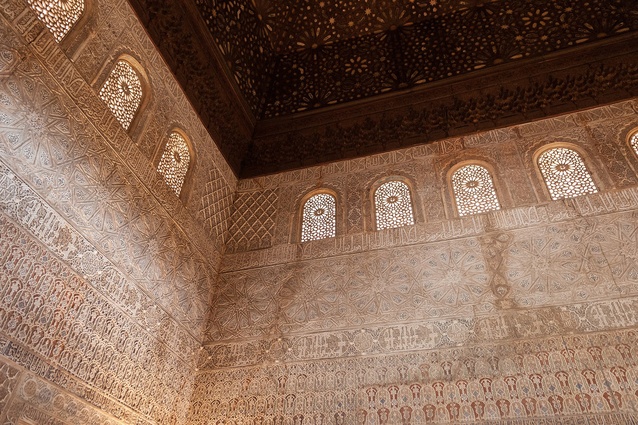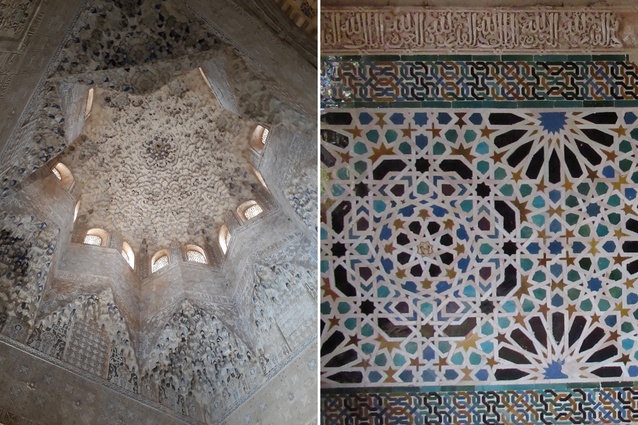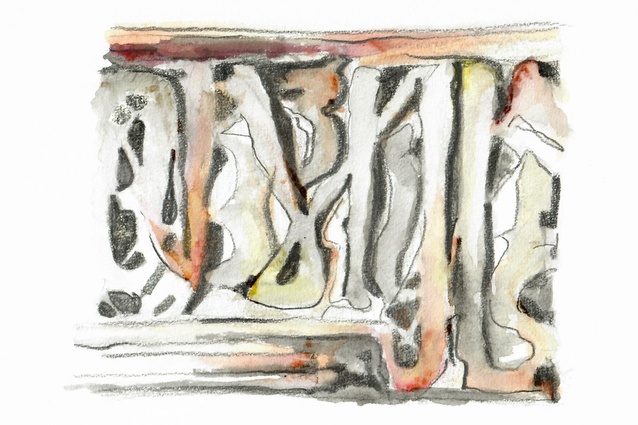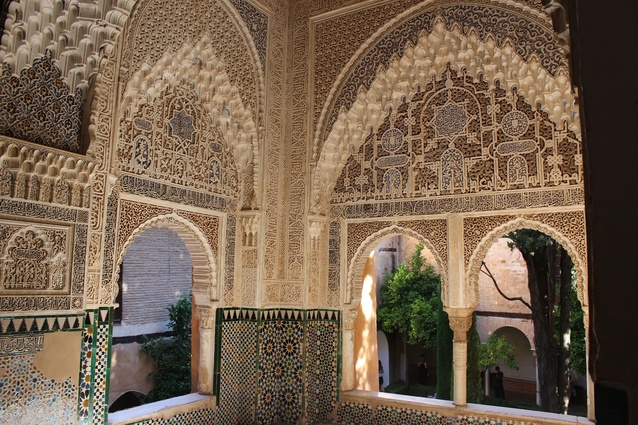The Alhambra: Looking into the past
Architecture student Naomi Vallis shares her experiences and reflections on the past and present of the Alhambra and Generalife, an iconic piece of Islamic architecture in Granada, Spain which she visited in the 6-week Spain and Morocco Study Tour. This was organized and run by Robin Byron, Francess Cooper, Dr.Mike Davis, Matt Liggins, and Michael Milojevic.
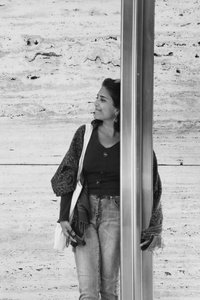
I come from Indian heritage, and on my many visits to my birth country, I have come into contact with the influence of various rulers and invaders upon architectural traditions, art and culture on the subcontinent of India. Over the centuries, several Muslim dynasties have ruled India and left a long-lasting impression on the land, from the Mughal in the north and Tipu Sultan in the South. Having visited many of these sites, I’ve had the opportunity to witness a fusion of styles, religions and traditions: the same kind of fusion that makes the experience of the Alhambra and Generalife so unique.
The beauty within Islamic architecture and design has long captured the interests of the west – and young, emerging architects – as a result of its widespread influence. The Islamic style is admired for many reasons but especially its success in translating key cultural values – something intangible – to a built form – the tangible. Its strong visual influence in monuments from Spain to North Africa and the Middle East has resulted in the adoption and appropriation of certain architectural features into a variety of modern projects and contexts.
Some of the features and qualities that have been admired and adopted are symmetry, mirroring and the use of geometry to create balance in the built form. Many of these traits are reflected within one of Spain’s finest examples of Islamic architecture: the Alhambra and Generalife.
The Alhambra (in Arabic: ‘Qal’at al-Hamra’, meaning ‘red fort’) is a Medieval palace and fortress built of the remains of the original Roman fortress, which was constructed in 889AD. The Generalife (Jannat al-‘Arīf, literally, ‘architect’s garden’), makes up the gardens and summer palace adjacent to the Alhambra. Upon first glance of the complex, the additive nature and varied built form is visually impactful.
This was a result of those in power making their own contributions to the monument or extending it. However, it is important to note the Alhambra and Generalife were constructed under the Moors, deriving the word “Moorish”, which was the name used to identify the population of people who arrived in Spain from North African or Arab origins.
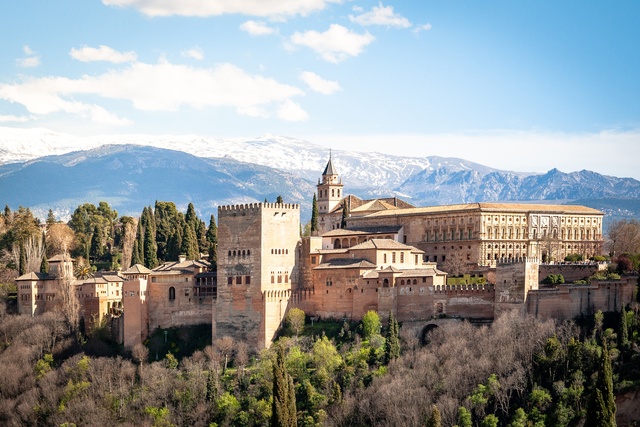
The Moors became the ruling dynasty of the south of Spain and patrons of the Alhambra and Generalife. Construction of the monument commenced under Muhammad I 1232-1492, one of the seven rulers of the Moorish Nasrid Dynasty and the last Muslim ruler of Spain. Under Muhammad’s rule, the pre-existing palace and walls were constructed, but the fortress was only converted into a royal palace under Yusuf I in 1333.
Once the Christian Reconquista of 1492 ended (the fall of the Islamic kingdoms to the expanding Christian kingdoms), the palace was transformed into a royal court for King Ferdinand and Queen Isabella. The Alhambra and Generalife now remain as one of the most visited sites within Spain, and in 1984 it was announced as a UNESCO World Heritage Site.
Like many of those who have laid eyes on the Alhambra and Generalife, the entire complex left quite the impression on me due to its unique style, beauty and scale; it is not surprising that the palace became a long-standing architectural influence not only for those who conquered Granada, but also for modern designers. In the weeks prior to visiting the Alhambra, the study tour spent one week travelling Morocco, which informed me on the widespread influence of the Moors within Southern Spain.
A direct visual connection can be made with the Islamic style within Marrakesh and the stylistic traits that inform the Alhambra. Today, the Alhambra and Generalife are some of the finest examples of architecture in the “Moorish Style.” This style was formed from the adoption and hybridisation of styles implemented upon the city of Granada and, through time, this has manifested itself as a cross-cultural relationship. This Moorish style is typically characterised by the use of horseshoe arches, Muqarnas (ornamented vaulting) and central courtyards with water features.
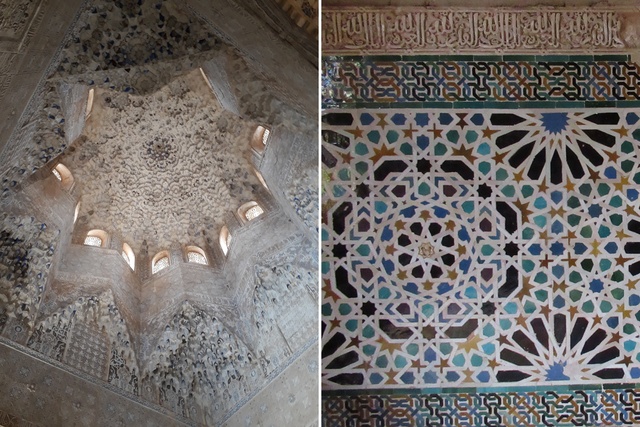
The word monument is not enough to describe the experience of the Alhambra and Generalife. The importance of the space becomes apparent in the great lengths ruling dynasties took in ensuring the safety of those who dwelled within the palace. The 26-acre (10.5-hectare) complex is enclosed by 1,730 metres of wall, in which 30 towers at different scales mount.
The scale of the site was a challenge to maneuvere within, and the day of our visit was unusually cold and rainy, making it difficult to read the site map that was displayed at several stations along the way. When walking within the Generalife, I found myself taking shelter in a number of the market stalls present within the gardens, selling crafts such as ceramic tiles and wood works. What caught my attention here was the shared knowledge or practice of the craft reflected in both the ornamentation of the Alhambra and souvenirs sold.
Ornamentation played a key role within Islamic design. Whilst providing beauty, ornamentation acted as a dress for the building, giving a purpose to each area, including structural responsibilities. The use of specific ornamentation added prestige to a space and person who occupied it. The meaning within the ornamentation was often derived from geometric compositions, where shapes were abstracted to reflect meaningful themes and concepts within Islamic culture. Whilst geometry was used as ornamentation, it is also reflected in planning of the Alhambra and many architectural features; hence, the relationship between architecture and ornamentation is important and cannot be separated.
There are three palaces that exist as the residence for the royal family, and they are possibly the most opulent areas of the complex. The Comares palace, the Palace of the Lions and the Partal palace each reveal unique experiences, despite being located close to one another. The Comares palace is most noted for it’s 45-foot (13.7-metre) Tower, which historically functioned as the Hall of Ambassadors or throne room for the Sultan.
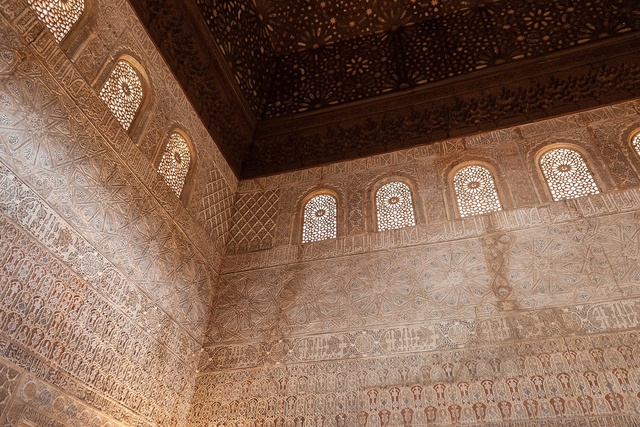
All surfaces of the Hall of Ambassadors are ornately decorated with linear bands of carved stucco, Islamic calligraphy and geometric tessellations of the natural world. It is said this chamber displays the finest examples of decorative arts combined with architectural features within the entire complex. Above these arabesque loops of ornamentation are perforated screens with latticework, also known as Jail Screens. These openings are set high upon the walls, allowing light to flood the chamber below.
The courtyard of the Myrtles belonged to the Comares Palace, which prioritised balance and symmetry. This is seen in the way the arches on the patio are reflected within the water, creating a mirroring image.
It is important to note that the beauty within Islamic design lies within the harmonious, geometric compositions that are used for planning but also for creating a sense of tranquillity between built form (an abstraction of the natural world) and the natural surroundings. Therefore, the natural world becomes a tool to replicate qualities within architecture. Such features were also common within the architectural traditions of Morocco and South Asia.
The second palace or courtyard was the Courtyard of the Lions; one of the most highly photographed spaces within the complex; it lived up to expectations. The name of the famous courtyard is derived from the 12 lion statues situated beneath a marble basin, which a highly advanced hydraulic system supplies water to. There are ceramic paths extending from all four corners of the basin, creating a strong line of vision and highlighting the cross formation of the space. The ornately carved stucco arches that encircle the courtyard are held up by slender columns, framing this view.

This palace was a personal favourite, especially for the use of Muqarnas, which can be defined as a “three-dimensional decorative device used widely in Islamic architecture, in which tiers of individual elements, including niche-like cells, brackets and pendants, are projected over those below”.1 Whilst being a highly ornate feature, the layering of brackets and pendants also acts as a structural feature allowing for the space below to remain open. The geometries composed in the recessed ceiling become visible from the flood of light from the alcoves, emphasising shadow and depth within the elaborate geometry.
Two-dimensional Islamic geometry provides an understanding of the formation of the three-dimensional space. The art of drawing Islamic geometry starts with the manipulation of a line, in which points are formed to create shapes, and then the act of infill is used to highlight or pull out the form of the tessellation. The art of drawing Islamic geometry is incredibly important as the Quran forbids figurative representations; thus, geometry was used to create abstractions of these subjects.
The existence of the Alhambra and Generalife today stand as a testament to the ability humankind has to appreciate the beauty around them. Still to this day, it continues to inspire those who come to visit the complex, including the group of 70 architecture students from University of Auckland that I travelled with. The experience has taught me the importance of the role of travel within the life of an emerging designer, which in turn broadens one’s perspective of what architecture is or was historically and is now at its current state (in different regions around the globe). However, more importantly, it teaches one the lesson of contextual design: formulating design to become applicable according to the varying cultures and lifestyles of the people.

